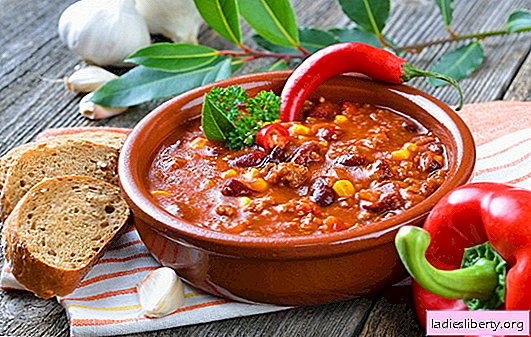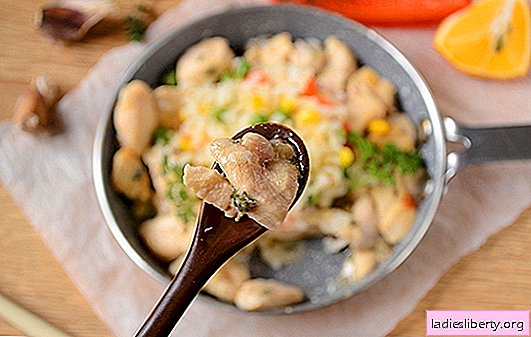
Diet number 9 - description and general principles
Diabetes mellitus is a very unpleasant disease associated with disorders of the endocrine system. As a result, the pancreas does not produce insulin in the right amount - a special hormone that is involved in the metabolic processes of many substances of the body, and plays a major role in carbohydrate metabolism. Therefore, in case of diabetes, it is necessary to organize your diet in such a way as to prevent fat disorders and ensure the normalization of carbohydrate metabolism in the body. In diabetes, food from the table is not suitable. Requires its own, individual culinary mode. This situation will help medical nutrition, in particular the diet number 9, the observance of which allows you to do without insulin injections, or reduce their dose. It is prescribed to those suffering from this disease in mild and moderate severity.
Diet number 9 is organized in such a way as to balance the chemical composition of food, and at the same time contain all the beneficial substances necessary for the normal functioning of the body. In this diet, sugar and sweets are excluded from the diet. When preparing sweet dishes, sweeteners are used - saccharin, sorbitol, xylitol and others. Increased content of vitamins, dietary fiber (fiber), lipotropic substances. The content of cholesterol, table salt, extractive substances is moderately limited. Proteins in the diet correspond to the physiological norm, but the content of animal fats and digestible carbohydrates is reduced, but not drastically, so you can stick to a diet for a long time. The daily diet should be divided into 5-6 receptions, distributing carbohydrates evenly throughout the day. There are no restrictions on temperature conditions - the temperature of the food served is normal.
Diet number 9 - what foods you can eat
1. Flour products and bread: protein-bran, wheat flour of the second grade, rye, protein-wheat. Total bakery products per day - no more than 300g. By reducing the daily rate of bread, it is allowed to include in the diet of non-flour flour products.
2. Soups: soup, beetroot soup, cabbage soup, vegetable and meat okroshka, any vegetable soups. Broths - mushroom, fish and meat with oatmeal, buckwheat, potatoes, vegetables, meatballs.
3. Meat and poultry: lean veal, beef, meat and edged lamb, pork, rabbit meat, turkey, boiled chicken, and also fried (after boiling) and stewed form, both chopped, and whole piece. Boiled tongue, diet sausage. Allowed to use the liver (limited).
4. Fish: low-fat fish in baked, boiled, and sometimes fried. Canned fish in tomato or own juice.
5. Fats: melted butter and unsalted butter, vegetable oil - only in dishes.
6. Eggs: soft-boiled, protein omelets, up to 1.5 per day, yolks with restriction.
7. Dairy products: fermented milk drinks, low-fat and semi-fat cottage cheese, dishes from it, milk, unsalted, low-fat cheese. With restrictions it is allowed to use sour cream.
8. Cereals: legumes, cereals from barley groats, buckwheat, oats, barley, millet. Cereal products are used sparingly, staying within the normal range of carbohydrates.
9. Vegetables: it is necessary to remember that some vegetables are rich in carbohydrates - potatoes, green peas, carrots, beets. Therefore, they must be included in the diet, given the daily rate of carbohydrates. Vegetables are preferable to use pumpkin, zucchini, cabbage, lettuce, cucumbers, eggplants and tomatoes, because they contain a small amount of carbohydrates. Vegetables are eaten raw, stewed, boiled, baked, and occasionally allowed to be fried.
10. Sweets, sweet dishes, fruits: mousses, jellies, compotes on xylitol, saccharin, sorbitol. With restrictions allowed honey. Fresh sweet and sour berries and fruits in any form.
11. Snacks: vegetable caviar, zucchini, vinaigrettes, aspic fish or meat, salads - from fresh vegetables, seafood, unsalted cheese, soaked herring, low-fat jelly (beef jelly).
12. Drinks: coffee with milk, tea, vegetable juices, from sweet fruits and berries, rosehip decoction.
13. Spices, sauces: tomato, vegetable broth, low-fat sauces on weak meat, mushroom and fish broths. Allowed in limited quantities - horseradish, mustard, pepper.
Diet number 9 - what foods can not eat
1. Flour products and bread: products and pastries from puff pastry and butter.
2. Soups: fatty and rich broths, milk soups with noodles, rice, semolina.
3. Meat and poultry: duck, goose, canned meat, fatty meats, smoked meats, most types of sausages and sausages.
4. Fish: fatty fish, salted, smoked, caviar, canned fish in oil and with added oil.
5. Fats: culinary and animal fat.
6. Eggs: fried.
7. Dairy products: cream, sweet curd cheeses, salty cheeses.
8. Cereals: pasta, semolina, rice - these products sharply limit or completely exclude.
9. Vegetables: salted and marinated.
10. Sweets, sweet dishes, fruits: figs, raisins, dates, bananas, grapes, sweets, sugar, jam, ice cream.
11. Snacks: smoked meat, spicy and over-salty snacks.
12. Drinks: carbonated drinks with sugar, grape juice and other sweet juices.
13. Spices, sauces: salty, spicy and fatty sauces, such as mayonnaise, soybean, tobacco, and the like.
Diet number 9 - examples of the menu
Monday
Breakfast (first): vegetable salad, seasoned with natural yoghurt, low-fat cottage cheese, tea.
Breakfast (second): fresh fruit.
Lunch: vegetarian pickle with sour cream (1/2 portions), boiled rabbit, stewed cabbage, compote on xylitol.
Lunch: cottage cheese and carrot casserole, sour cream (1/2 portions).
Dinner: fish steamed patties, vegetable stew, tea with xylitol.
For the night: low-fat kefir.
Tuesday
Breakfast (first): cottage cheese soufflé, grated raw carrots with apple and honey (1 tealozh.), Coffee with milk without sugar.
Breakfast (second): savory buckwheat porridge with butter, a glass of milk.
Lunch: chicken broth soup with pearl barley, fried (after boiling) chicken, carrot puree, tomato juice.
Safe,: fresh berries (on season) or apples.
Dinner: boiled fish, vinaigrette, tea with sweetener.
For the night: non-fat yogurt.
Wednesday
Breakfast (first): carrot-cheese pudding, protein omelet, tea with sweetener.
Breakfast (second): oatmeal with milk.
Lunch: soup with meat from sauerkraut and sour cream, jellied fish, mashed potatoes, cabbage salad (fresh), tomato juice.
Safe, apples fresh.
Dinner: low-fat or low-fat cottage cheese, fresh tomatoes, green tea.
For the night: low-fat kefir.
Thursday
Breakfast (first): cheesecakes, sour cream, grated carrots, coffee with milk.
Breakfast (second): pea porridge, natural low-fat yogurt.
Lunch: vegetable soup, mashed stew (after boiling) beef, buckwheat porridge, tomato (or white lean) sauce, xylitol compote.
Lunch: a slice of unsalted cheese, fresh apple.
Dinner: vegetable ragout of zucchini and potatoes, diet sausage, tea with sorbitol.
For the night: low-fat kefir.
Friday
Breakfast (first): millet porridge with milk and pumpkin on xylitol, a slice of unsalted cheese, tea.
Breakfast (second): low-fat cottage cheese, a glass of milk.
Lunch: pea soup with meat, white cabbage stewed on vegetable oil, boiled chicken, tomato juice.
Tea time: fresh orange.
Dinner: vinaigrette, a piece of soaked herring, broth hips.
For the night: non-fat yogurt.
Saturday
Breakfast (first): steam protein omelet, fresh tomatoes and cucumbers (in salad or natural form), a slice of unsalted cheese, bread, tea.
Breakfast (second): fresh apples.
Lunch: potato soup in chicken broth with meatballs, pea porridge, boiled beef, sauce, cranberry juice.
Lunch: berry mousse on xylitol.
Dinner: cabbage schnitzel, fish meatballs baked under white sauce, tea.
For the night: low-fat kefir.
Sunday
Breakfast (first): cottage cheese with milk, soft-boiled egg, tea with xylitol.
Breakfast (second): fruit jelly on xylitol, viscous buckwheat porridge with milk.
Lunch: soup with meat and sour cream, vegetable stew, baked (after boiling) rabbit in white sauce, zucchini fritters, compote on xylitol.
Safe,: fruits (berries) fresh.
Dinner: lean beef aspic, vegetable caviar, tea with milk.
For the night: low-fat kefir.
Diet number 9 - useful tips and reviews
Often, people with diabetes experience an increased feeling of hunger, so you should try to include low-calorie foods, but rich in fiber, such as cucumbers, carrots, zucchini, pumpkin, cabbage. The organism spends a lot of time for their processing, which is just enough until the next snack. At the same time, fiber helps to maintain sugar levels, which reduces cravings for sweets.
Comments











